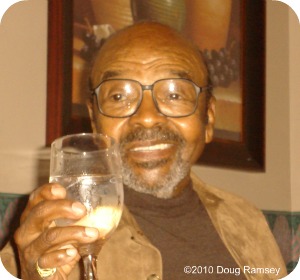Rifftides: December 2010 Archives
At this time of year, those who write about music, books, plays, motion pictures, sporting events, chili cookoffs, hog-calling contests and—for all I know—goldfish breeding, are expected to compile lists of the year's best. I have been complicit in this questionable activity, but I've been trying to quit.
In the case of jazz recordings, the notion is absurd that anyone can name the best. You 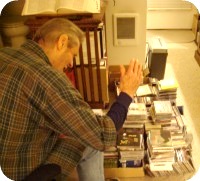 could listen for 12 months during all of your waking hours and not hear, much less evaluate, a tenth of a year's output of albums. After a few weeks you would be babbling, taken away in a straitjacket. As I have written here, possibly to the point of annoyance, it is impossible to keep up with jazz releases in an era when digital technology enables musicians to be their own record companies. The irony is that they flood a dwindling market.
could listen for 12 months during all of your waking hours and not hear, much less evaluate, a tenth of a year's output of albums. After a few weeks you would be babbling, taken away in a straitjacket. As I have written here, possibly to the point of annoyance, it is impossible to keep up with jazz releases in an era when digital technology enables musicians to be their own record companies. The irony is that they flood a dwindling market.
Nonetheless, my resistance is no match for the irresistible force known as Francis Davis. Francis is the distinguished author and critic who compiles for The Village Voice its annual jazz critics poll. Once again, he persuaded me and 119 other critics (who knew that there are 120 jazz critics?) to submit lists. In the elegant introduction to his massive survey, Mr. Davis writes:
This poll has become my labor of love—my equivalent of social networking, and, for a couple weeks once the ballots start filling my inbox, just about my only social life. Alongthe way this year, in addition to a hundred or so albums I might otherwise not ever have known existed, I also got word of layoffs and cutbacks, a corneal abrasion, a nagging heel injury, the death of a mother, the birth of a daughter, and the loss of James Moody to pancreatic cancer. Thanks to this year's 120 participants for keeping me up to date.
He then goes on to name the 120, link to their previous years' entries and provide another link that takes readers to all 120 best-of lists. Even if you don't make it through all of the lists, you will find it worthwhile to read Francis's essay, which contains the list of overall winners based on an average of the critics' findings, and his own best-of list with incisive evaluations. Of course, the notion of "winners" in the arts should be anathema, but like the poor, polls and ratings we shall always have with us.
It is not giving away too much to disclose that Jason Moran's Ten came out first. For the rest of the results, go to Francis's article in The Village Voice. My list appears below. If I had compiled it a day earlier or a day later, it might have been different.
•New Releases
James Moody: 4B (IPO)
Evans, Reavis, Waits (Tarbaby): The End of Fear (Posi-tone)
Chet Baker: The Sesjun Radio Shows (T2)
Randy Weston: The Storyteller (Motéma)
Jason Moran: Ten (Blue Note)
Jessica Williams: Touch (Origin)
Irene Kral: Second Chance (Jazzed Media)
Alan Broadbent: Live At Giannelli Square, Volume 1 (Chilly Bin)
Keith Jarrett, Charlie Haden: Jasmine (ECM)
Kirk Knuffke: Amnesia Brown (Clean Feed)•Reissues
Nat King Cole & Friends: Riffin', The Decca, JATP, Keynote and Mercury Recordings (Verve)
Miles Davis: Bitches Brew 40th Anniversary (Columbia)
The Bing Crosby CBS Radio Recordings 1954-56 (Mosaic)•Vocal Album
Irene Kral: Second Chance (Jazzed Media)
• Debut CD
Jeff Chang: It's Not What You Think (Chee May)
• Latin jazz CDGabriel Alegría: Pucusana (Saponégro)
Oregon Music News has a line on its masthead listing the categories the online publication covers:
CLASSICAL, JAZZ/BLUES, ROCK/ROOTS, ACOUSTIC, INDIE, DJ/ELECTRO, SOUL/HIP-HOP, MELTING POT, FAMILY, MUSICALS
I don't spend much time with two-thirds of those genres and although I found it enlightening to rummage through the OMN sections about them, I doubt that I will be delving deeply into, say, DJ/Electro. I'm glad it's there for those who need it. The current lead story in the jazz section is Jack Berry's "Saga of the not-so-lost Oregon Jazz treasure trove (part 2)." Berry updates questions about the fate of a cache of reel-to-reel audio tapes and videos recorded over the years by the late sound man Bob Thompson.
Among the musicians Thompson captured were Art Pepper, Jim Pepper, David Friesen, Dave Frishberg, Floyd Standifer, Nancy King and a few dozen other musicians better known in the Pacific Northwest than they are nationally. The recordings now belong to the Jazz Institute of Los Angeles, where they are stored with no apparent plan for their permanent preservation or eventual release. If there is other music of the quality of a clip of the late tenor saxophonist Jim Pepper, bassist David Friesen and drummer Ron Steen in a basement session, let's hope that the institute has something in mind. To read Berry's story and hear Friesen, Pepper and Steen play "My One and Only Love" (mistitled "Bolivar Blues"), click here.
permanent preservation or eventual release. If there is other music of the quality of a clip of the late tenor saxophonist Jim Pepper, bassist David Friesen and drummer Ron Steen in a basement session, let's hope that the institute has something in mind. To read Berry's story and hear Friesen, Pepper and Steen play "My One and Only Love" (mistitled "Bolivar Blues"), click here.
Billy Taylor, a pianist who became a television and radio spokesman for jazz and made the music familiar to millions, died last night in a New York City hospital after suffering 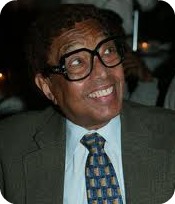 heart failure at home. He was 89. In his work on National Public Radio and CBS-TV's Sunday Morning, Taylor's playing and relaxed explanations dispelled for many listeners and viewers the notion that jazz was remote, impenetrable and difficult. He earned a doctorate in music in 1975 and chose to be called Dr. Taylor, a title that suited his professorial side. For a summary of his career and accomplishments, see the obituary by Peter Keepnews in The New York Times.
heart failure at home. He was 89. In his work on National Public Radio and CBS-TV's Sunday Morning, Taylor's playing and relaxed explanations dispelled for many listeners and viewers the notion that jazz was remote, impenetrable and difficult. He earned a doctorate in music in 1975 and chose to be called Dr. Taylor, a title that suited his professorial side. For a summary of his career and accomplishments, see the obituary by Peter Keepnews in The New York Times.
Taylor was born into a middle class North Carolina family and grew up in Washington, D.C. When he arrived in New York in 1943, he was educated, articulate and eager to build on his solid foundation in music. I spoke at length with him as I prepared the notes for the reissue of several of his early 1950s recordings in Billy Taylor Trio. An excerpt gives an idea of the intellectual curiosity he brought to his early music-making and of the difference he made in the development of jazz piano.
The young pianist went to work for tenor saxophonist Ben Webster at the Three Deuces. Unlike most horn soloists, Webster encouraged Taylor's use of rich chords in accompaniment. Taylor was inspired harmonically by Duke Ellington's piano introduction to "In a Mellotone," which he heard when he was a student.
"That wiped me out," Billy says. "I said, 'What's he doing?' So I figured it out. It was an A-flat ninth in the left hand and an octave with a fifth—A-flat, E-flat, and A-flat—in the right hand. I liked it and began fooling around with it, added a couple of things to it; one voicing in one hand and another voicing in the other. By the time I came to New York, that was a part of my approach. Most horn players said, 'That's in my way' because they were used to being accompanied around middle C, in the lower part of the piano. I was an octave higher. Ben was a former pianist. He liked it and encouraged me to do it."Over the next decade, Taylor refined his chord-plus-octave style. By the time he had realized his ambition to form a permanent trio and went into the Prestige studio in late 1952, the sophisticated technique was in his musical grain. By then, a Taylor harmonic invention might be built like this: B-flat, C-ninth, E, and G or G-13th in the left hand, C, E, G and C in the right hand.
"I was harmonically oriented," he says, a masterpiece of understatement. "In those days a lot of these harmonies were not common. I was very proud that I was able to establish them."
When the recordings at hand were released as 78-RPM singles, Taylor's harmonies reached the ears of many pianists, who adapted them to their own playing. Later in the fifties the sound was to be identified with Red Garland, a pianist who rose to fame as a member of the Miles Davis Quintet. But Taylor pioneered the approach.
There are dozens of Billy Taylor videos on YouTube, part of his legacy of media visibility. In this one, he plays a decidedly two-handed blues. The interested onlooker is fellow pianist John Lewis.
No remembrance of Taylor would be complete without his most famous composition, "I Wish I Knew How it Would Feel to be Free," the piece that became an anthem of the civil rights movement. Here, he plays it with bassist Victor Gaskin and drummer Curtis Boyd.
Finally, a memory from April of 1969, a rehearsal of the all-star band that performed for Duke Ellington's 70th birthday celebration at the White House. It recalls Taylor's magnanimity and the respect other musicians had for him. The pianists on hand included Taylor and Dave Brubeck, both of whom would be featured that night. A photographer approached them and said, "Can I get one of you together?"
"Sure," Billy told him. "Maybe something will rub off."
"I hope so," Brubeck said, "—On me."
Many Rifftides readers may be familiar with Erik Satie's "Gymnopédie No. 1" because performers including Jessica Williams, Jacques Loussier, Ximo Tébar and Herbie Mann with Bill Evans have recorded jazz or near-jazz versions of that classic of French music. It has not become a jazz standard, but it has assumed a modest place in the repertoire. For those who have not heard the piece as Satie wrote it in 1888, here it is, played by the eminent Satie interpreter Aldo Ciccolini. The performance is from a 1979 Canadian broadcast.
At 85, Ciccolini continues to perform Satie, Debussy, Ravel, Janáček and Schumann, among others. This collection contains most, if not all, of his recordings of Satie's music.
Jack Tracy died on Tuesday, December 21. He was 84. Jack was editor of DownBeat magazine in the 1950s and went on to a second career producing fine jazz recordings. He was a frequent Rifftides commenter. We shall miss his knowledge, pointed observations, humor and friendship.
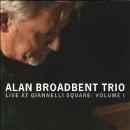 Alan Broadbent Trio Live At Giannelli Square: Volume 1 (Chilly Bin). No outer space explorer, Broadbent finds in the song form all that he needs for freedom earned through discipline. The technique he has intensified in recent years is evident in the precision and relaxation of his counterpoint in "Lullaby of the Leaves," stunning parallel constructions, speed and independence of hands in "Solar" and in dozens of other demonstrations of his skill. Broadbent's music, however, is not about chops. He concerns himself with beauty. The manifestations of it include his poignant reharmonization of "Embraceable You," called here "You and You Alone." Broadbent's longtime sidemen, bassist Putter Smith and drummer Kendall Kay, are strong and sensitive in support.
Alan Broadbent Trio Live At Giannelli Square: Volume 1 (Chilly Bin). No outer space explorer, Broadbent finds in the song form all that he needs for freedom earned through discipline. The technique he has intensified in recent years is evident in the precision and relaxation of his counterpoint in "Lullaby of the Leaves," stunning parallel constructions, speed and independence of hands in "Solar" and in dozens of other demonstrations of his skill. Broadbent's music, however, is not about chops. He concerns himself with beauty. The manifestations of it include his poignant reharmonization of "Embraceable You," called here "You and You Alone." Broadbent's longtime sidemen, bassist Putter Smith and drummer Kendall Kay, are strong and sensitive in support.
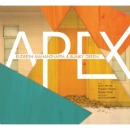 Rudresh Mahanthappa & Bunky Green, Apex (Pi). Mahanthappa, aged 39, is one of the most visible alto saxophonists of the 21st century; Green, aged 75 one of the least. As a result of this album, Green is gaining the prominence he might have achieved in the 1960s had he not left Charles Mingus for academia. Among the saxophonists he influenced through recordings was Mahanthappa. Together, they are formidable kindred spirits. Throughout, but notably on "Summit" and "Playing with Stones," their singleness of purpose, interplay and energy are remarkable. Pianist Jason Moran, bassist Francis Moutin, and drummers Jack DeJohnette (four tracks) and Damion Reid (six tracks) abet this inspired pairing.
Rudresh Mahanthappa & Bunky Green, Apex (Pi). Mahanthappa, aged 39, is one of the most visible alto saxophonists of the 21st century; Green, aged 75 one of the least. As a result of this album, Green is gaining the prominence he might have achieved in the 1960s had he not left Charles Mingus for academia. Among the saxophonists he influenced through recordings was Mahanthappa. Together, they are formidable kindred spirits. Throughout, but notably on "Summit" and "Playing with Stones," their singleness of purpose, interplay and energy are remarkable. Pianist Jason Moran, bassist Francis Moutin, and drummers Jack DeJohnette (four tracks) and Damion Reid (six tracks) abet this inspired pairing.
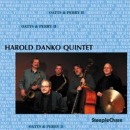 Harold Danko, Oatts & Perry II (SteepleChase). Pianist Danko was a colleague of alto saxophonist Dick Oatts and tenor saxophonist Rich Perry in the Thad Jones-Mel Lewis band and never got over them—with good reason. This successor album to Oats & Perry (2006) again teams the three with bassist Michael Formanek and drummer Jeff Hirshfield. It reemphasizes the reasons that Oatts and Perry are admired among musicians and serious listeners for their inventiveness, passion and tonal qualities. In addition, it has plenty of Danko's incisive soloing. They glorify tunes by Danko, Jones, Wayne Shorter, Horace Silver, Richard Rodgers, Johnny Mercer and Miles Davis, whose "Sid's Ahead" is a moody highlight.
Harold Danko, Oatts & Perry II (SteepleChase). Pianist Danko was a colleague of alto saxophonist Dick Oatts and tenor saxophonist Rich Perry in the Thad Jones-Mel Lewis band and never got over them—with good reason. This successor album to Oats & Perry (2006) again teams the three with bassist Michael Formanek and drummer Jeff Hirshfield. It reemphasizes the reasons that Oatts and Perry are admired among musicians and serious listeners for their inventiveness, passion and tonal qualities. In addition, it has plenty of Danko's incisive soloing. They glorify tunes by Danko, Jones, Wayne Shorter, Horace Silver, Richard Rodgers, Johnny Mercer and Miles Davis, whose "Sid's Ahead" is a moody highlight.
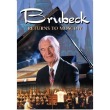 Dave Brubeck, Brubeck Returns to Moscow (Koch Vision). This 2005 film about Brubeck's 1997 visit to Russia for a performance of his mass To Hope is a beautifully crafted documentary. It incorporates Brubeck's quartet with a symphony orchestra and chorus performing the mass and a rousing "Blue Rondo ala Turk." We see Brubeck's informal encounters with the Russians, including a spirited impromptu duet with a young violinist, and conductor Russell Gloyd amusingly overcoming the language difference to rehearse the dozens of musicians. There is also footage of Brubeck on a previous Moscow occasion, at the Reagan-Gorbachev summit of 1988, before the wall came down.
Dave Brubeck, Brubeck Returns to Moscow (Koch Vision). This 2005 film about Brubeck's 1997 visit to Russia for a performance of his mass To Hope is a beautifully crafted documentary. It incorporates Brubeck's quartet with a symphony orchestra and chorus performing the mass and a rousing "Blue Rondo ala Turk." We see Brubeck's informal encounters with the Russians, including a spirited impromptu duet with a young violinist, and conductor Russell Gloyd amusingly overcoming the language difference to rehearse the dozens of musicians. There is also footage of Brubeck on a previous Moscow occasion, at the Reagan-Gorbachev summit of 1988, before the wall came down.
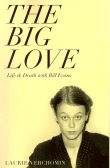 Laurie Verchomin, The Big Love: Life & Death With Bill Evans (Verchomin). The "Laurie" of the pianist's song by that name spares nothing in her account of their romance or of the drug use that hastened Evans' death at 51. Love between the pianist and the young woman flared in the year-and-a-half before Evans died in late 1980. Her book is the story of the life-affirming brilliance of his music in the final months, a man resigned to the inevitability of his early mortality and the devotion of the young woman he chose to share the end of his life. The drug ugliness is at odds with the beauty of Evans' music, but Ms. Verchomin illuminates his generosity, consideration and humor.
Laurie Verchomin, The Big Love: Life & Death With Bill Evans (Verchomin). The "Laurie" of the pianist's song by that name spares nothing in her account of their romance or of the drug use that hastened Evans' death at 51. Love between the pianist and the young woman flared in the year-and-a-half before Evans died in late 1980. Her book is the story of the life-affirming brilliance of his music in the final months, a man resigned to the inevitability of his early mortality and the devotion of the young woman he chose to share the end of his life. The drug ugliness is at odds with the beauty of Evans' music, but Ms. Verchomin illuminates his generosity, consideration and humor.
 A flurry of deadlines for other projects meant that it took a while to get the new batch of recommendations ready, but they are posted. In the center column under the legend Doug's Picks you will find suggestions of CDs by pianists and saxophonists, a DVD documentary about a momentous event in Moscow and a book about the last days and last love of Bill Evans.
A flurry of deadlines for other projects meant that it took a while to get the new batch of recommendations ready, but they are posted. In the center column under the legend Doug's Picks you will find suggestions of CDs by pianists and saxophonists, a DVD documentary about a momentous event in Moscow and a book about the last days and last love of Bill Evans.
The other day a man who acted on last year's Rifftides recommendation of Carla Bley's Carla's Christmas Carols let me know that he was disappointed in the album. Indeed, he was offended by it. In the review, I described the "tenderness, wit, harmonic brilliance, wide dynamic range and wry sense of nostalgia" in Bley's arrangements of traditional holiday songs. My friend said that he likes his Christmas songs straight, without "all those minors." I refrained from a discussion of the importance of minor chords, scales, keys and intervals.
If you don't mind adventurism, including minors, in holiday music, Matt Wilson's Christmas Tree-O (Palmetto) gives you plenty of it. To 14 traditional songs and a couple of modern classics the drummer brings his customary humor, infectious swing, ingenuity with assorted percussion instruments and—now and then—good-natured raucousness. Wilson's trio mates are saxophonist-flutist-clarinetist Jeff Lederer and bassist Paul Sikivie. Lederer is on tenor sax in "Winter Wonderland" and the band has  the sound and feeling of Sonny Rollins in his Way Out West and Village Vanguard trio days of the 1950s. With Wilson using bells, the music combines prayerfulness and avant garde abandon in a medley of Albert Ayler's "Angels" and the traditional "Angels We Have Heard on High." The liberated spirit of Christmas present continues with vigor in Vince Guaraldi's "Christmas Time is Here." As the three waltz with lighthearted seriousness through "The Chipmunk Song," Lederer's soprano sax takes the chattery title role. In "You're a Mean One, Mr. Grinch," Lederer's bass clarinet and Sikivie's bass generate an atmosphere of menace that Wilson penetrates with deft brush work.
the sound and feeling of Sonny Rollins in his Way Out West and Village Vanguard trio days of the 1950s. With Wilson using bells, the music combines prayerfulness and avant garde abandon in a medley of Albert Ayler's "Angels" and the traditional "Angels We Have Heard on High." The liberated spirit of Christmas present continues with vigor in Vince Guaraldi's "Christmas Time is Here." As the three waltz with lighthearted seriousness through "The Chipmunk Song," Lederer's soprano sax takes the chattery title role. In "You're a Mean One, Mr. Grinch," Lederer's bass clarinet and Sikivie's bass generate an atmosphere of menace that Wilson penetrates with deft brush work.
Through "Snowfall," "Hark the Herald Angels Sing", and all the others, Wilson, Lederer and Sikivie decorate familiar music with unconventional ideas. The album has the comedy of "Mele Kalikimaki" as a polka with a bonkers clarinet solo, and "Little Drummer Boy" as the bebop vehicle for a wonderfully structured short Wilson drum solo. Alternating wildness and calm, Wilson and company inject irony into Handel's "Hallelujah Chorus," but the CD also has lyrical readings of "Snowfall" and "I'll Be Home For Christmas." This is the most stimulating Christmas collection I have heard this year.
Greta Matassa & Clipper Anderson, And to All a Good Night (Origin).
To ears accustomed to hearing the same holiday songs again and again, Matassa's and Anderson's repertoire is fresh. The composer and lyricist credits include familiar names—Johnny Mandel, Marilyn and Alan Bergman, Victor Young, Burt Bacharach, Henry Mancini and Irving Berlin. But the Mandel-Bergman "A Christmas Love Song," Bacharach's and Hal David's "Christmas Day" or Bill Mays' and Mark Murphy's "November in the Snow" have not been played ad nauseum in department stores and super markets. Berlin's "Count Your Blessings" may be the most familiar song here. Yet, despite its origin in the movie classic Holiday Inn, it is not often included in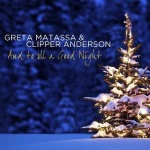 Christmas collections.
Christmas collections.
Matassa is one of the best-known vocalists on the west coast, Anderson one of the most respected bassists. They have been a team for several years, with Anderson singing and playing in live appearances. Now, on record he makes it clear that he is a substantial vocalist with admirable timbre, intonation and phrasing. In his duet with pianist Darin Clendenin on "Count Your Blessings," for three minutes Anderson can make you forget that Bing Crosby owned the song. Matassa shines here, bringing restraint to the tender songs, art-song refinement or her signature bluesy passion to others. She polishes facets of all of those attributes in the medley of "It's Christmas Time" and "Sleep Well, Little Children." Clendenin and drummer Mark Ivester join Anderson's powerful bass in the rhythm section. Susan Pascal is on vibes in three pieces. Ivester's two young daughters add the charm of their voices to Matassa's in "Where Can I Find Christmas?"
The Norwegian pianist, composer and bandleader Per Husby writes:
I'd like to share a little remembrance of mine of James Moody - from Oslo, Norway somewhere around 1990: I had been playing piano with Moody on some gigs atthe Molde jazz festival in 1979, and had met him sporadically here and there after that. On this occasion in 1990 he had done a gig in Oslo with a Swedish rhythm section - and Moody had played fantastically as usual. I spoke to him in the interval, and he enthusiastically showed me a bunch of pictures of him and his wife - who was apparently half Norwegian.
It turned out that he had the next day off - so I took him up for lunch in a restaurant in the forest outside of Oslo, on a hilltop overlooking the city. He was really enjoying the meal, but at the same time he seemed to be bothered about something, so after a while I asked him what was the matter. He then looked almost frightened around him to ensure nobody was listening in (the place was nearly empty except for us) - leaned over towards me, and whispered very reluctantly with eyes still going left and right: "Per - I wanna ask you a question.... Do you think I thound old??" I do not remember what my answer was - because all I could think of was that here is one of the world's leading saxophonists of all time sitting way out in the wilderness together with a local rhythm section pianist andasking for assessment - from me, who had just experienced him being as fantastic as ever only the night before.
This little incident has stayed in my mind since then as a wonderful snapshot of the truly great, respectful and human soul James Moody represented. For fun, I'm putting in a link to a little private clip from Molde in 1979 typical of Moody, where he - without any prior notice to us - goes into "Oop-Pop-A-Da" and even manages to get our trumpeter (who is a very soft-spoken person and surely never a vocalist at all) to join in some two-part scat harmony. For all its recording faults this cut, to me, represents jazz as entertainment on a high level - and also has some tenor playing going all the way back to his 1940s background.
http://www.jazzdiscography.com/Temp/Moody.mp3
Mr. Husby's story was in a message to the Jazz Research Group. Rifftides uses it with his permission.
To see previous entries about Moody, who died on December 9, go here, then here.
Today is Clark Terry's 90th birthday. Admired for his trumpet, flugelhorn, singing and blues mumbling, Terry has been an idol of trumpet players since the teenaged Miles Davis took him for a role model in St. Louis in the 1940s. From his days with Charlie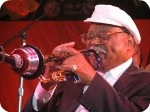 Barnet, Count Basie and Duke Ellington through his national prominence in the Tonight Show band and his long career as a leader and soloist, CT has been an inspiration to generations of musicians. It is a rare set in which Terry doesn't include something by Ellington, whom he invariably calls Maestro. Here's CT with his quartet at the Club Montmartre in Copenhagen in 1985. Duke Jordan is the pianist, Jimmy Woode the bassist, Svend E. Noregaard the drummer
Barnet, Count Basie and Duke Ellington through his national prominence in the Tonight Show band and his long career as a leader and soloist, CT has been an inspiration to generations of musicians. It is a rare set in which Terry doesn't include something by Ellington, whom he invariably calls Maestro. Here's CT with his quartet at the Club Montmartre in Copenhagen in 1985. Duke Jordan is the pianist, Jimmy Woode the bassist, Svend E. Noregaard the drummer
From Jazz Matters: Reflections on the Music and Some of Its Makers, here is a passage from the chapter on Terry:
With Ellington, Terry blossomed. Duke's genius for recognizing and capitalizing on the characteristics of his sidemen has rarely had more startling results than in the case of Clark Terry.
Ellington sensed in Terry something of the New Orleans tradition. When he was preparing A Drum Is A Woman, his suite in which New Orleans plays a large part, he chose Terry to portray Buddy Bolden. Bolden's style is entirely legendary; no recordings of him areknown to exist. Terry recalls protesting the assignment.
"I told him, 'Maestro, I don't know anything about Buddy Bolden. I wouldn't know where to start.' Duke said, 'Oh, sure, you're Buddy Bolden. He was just like you. He was suave. He had a good tone, he bent notes, he was big with diminishes, he loved the ladies, and when he blew a note in New Orleans, he'd break glass across the river in Algiers. Come on, you can do it.' I told him I'd try, and I blew some phrases, and he said, 'That's it, that's Buddy Bolden, that's it, Sweetie.' That's how Maestro was. He could get out of you anything he wanted. And he made you believe you could do it. I suppose that's why they used to say the band was his instrument. The Buddy Bolden thing is on the record, and Duke was satisfied. So as far as I'm concerned, it was Buddy Bolden."
On this auspicious day in Clark Terry's long life, let us indulge ourselves in one of his great summit meetings. At the Montreux Jazz Festival in 1977, he, Dizzy Gillespie, Eddie Lockjaw Davis and the Oscar Peterson Trio joined forces for the incomparable "Ali and Frazier,"introduced on this video by Norman Granz.
As Ken Dryden points out in the first comment below, "Ali & Frazier" is also on this CD.
Happy birthday, CT.
Jeremiah McDonald writes:
Years ago you featured my Jazz Dispute video on your blog, and I just wanted to let you know that I recently a second version for the French theater that I now work for. It's the same recording of "Leap Frog," but performed a little differently...
Yes, a little differently. The music was by Charlie Parker, Dizzy Gillespie, Thelonious Monk, Curley Russell and Buddy Rich, recorded June 6, 1950. Thanks to Mr. McDonald for the alert to his new version. To see his original interpretation, click here.
I thought that we had come to the end of the current Rifftides series of James Moody entries until I heard from a reader who wondered why she had never heard Moody's "I'm in the Mood for Love." That is a puzzle, given the record's ubiquity, but if even one person has the pleasure of hearing it for the first time, how can we refuse? Here is Moody's 1949 recording with the Swedish All-Stars, followed by King Pleasure (Clarence Beeks) in 1952 singing Eddie Jefferson's lyric set to Moody's solo. Blossom Dearie sings the bridge originally improvised by pianist Thore Swaneberg. I'm glad our reader asked. This is a good way to start the week.
We knew it was coming. That doesn't make it easier. James Moody died this afternoon of the pancreatic cancer he had known about for nearly a year but did not make public until 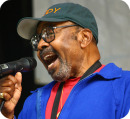 November. He was 85. Moody was in hospice in San Diego, his hometown for many years. His wife Linda was by his side, as she was almost every moment since they met.
November. He was 85. Moody was in hospice in San Diego, his hometown for many years. His wife Linda was by his side, as she was almost every moment since they met.
Moody became famous for his solo on "I'm In The Mood For Love," a record he made when he was 24. His friend Eddie Jefferson put a lyric to it and it became "Moody's Mood For Love." The lengthy obituary by George Varga in The San Diego Union-Tribune contains a passage about Moody's reaction to the fuss over the record. It captures the combination of modesty, confidence and kindness that endeared him to everyone with whom he came in contact.
"I don't pay any attention to that stuff," he said. "When I made that record, I was a tenor saxophonist playing alto for the first time on record and I was trying to find the right notes, to be truthful. People later said to me: 'You must have been very inspired when you recorded that.' And I said: 'Yeah I was inspired to find the right notes!' "He recorded "Moody's Mood for Love" in Sweden in 1949, during a European visit that started as a three-week vacation and lasted several years. Being abroad was an eye-opening experience for Mr. Moody, who never forgot the racism he encountered here in his native country, both before and after his European sojourn.
"In America, I thought there was something wrong with me," said Mr. Moody, who recalled how, as an Air Force private in North Carolina, he was not allowed to eat in the same restaurants where German prisoners of war dined.
"In Paris, they treated me like they treated each other, which was altogether different from how they treated me here. When I was in France, I said: `Ah, it isn't me (that's the problem in America), it's them.' I felt good, and now I know there's no one in this world who's better than me. By the same token, I'm not better than anyone else."
Moody's funeral will be in San Diego on December 18. Details are in the Union-Tribune obituary. Peter Keepnews's obituary in The New York Times has an extensive review of Moody's career from his earliest days with Dizzy Gillespie's big band in the early 1940s. For previous Rifftides pieces about Moody, go here and here.
The last time we were together, we were in a roomful of friends enjoying dinner and one another's company. During a round of toasts I caught Moody raising his glass of water with lemon just after he said, "To us. To life."
Extracurricular assignments will keep me busy for a while. The Rifftides staff will supply items to inform or entertain you. There's not much information in this one, but it may lift your spirits if, say, snow collapsed your roof or Julian Assange leaked one of your cables.
Fats Waller in 1934 with Gene Sedric, tenor saxophone; Herman Autrey, trumpet; Harry Dial, drums; Billy Taylor, Sr., bass. I've always been impressed with Autrey's ability to insert lovely little obligato licks among phrases of Waller's vocal. "Don't Let it Bother You" is included in this CD collection.
Dave Brubeck is spending his 90th birthday in the midst of his sizeable family and many close friends. Chances are that they will take time out to watch the documentary about his life. As they reminisce, it's almost certain that Dave will tell a Blackhawk story or two. The club in San Francisco's Tenderloin district was his quartet's headquarters for years before and after they became famous. It was the location of a pilot for a television series that never get off the ground. Mort Sahl, a friend and fan of the band, introduced the show. A wide shot near the beginning gives us a full view of the little club somebody once called "the temple of gloom." The TV lights that day probably gave it the most illumination it ever saw. It was lit up by Brubeck, Miles Davis, Cal Tjader, Count Basie, Chet Baker, Art Tatum, Carmen McRae and most of the other jazz luminaries of the 1950s.
The Blackhawk is long gone. Brubeck is thriving. Here is a rare look at the classic quartet—Brubeck, Paul Desmond, Eugene Wright and Joe Morello—at the Blackhawk:
Happy Birthday, Dave.
The Christmas season is underway. This makes it official.
Someone went overboard matching the color scheme of this video to the name of the tune, and the sound is distorted, but here is an exquisite 1962 version of "Blue in Green" by Bill Evans with Chuck Israels and Paul Motian. Be patient while the YouTube poster gets his commercial out of the way.
There was a time when the big three television networks had programs that presented music of quality. CBS-TV's Camera 3, the original source of this clip, went out of business in 1980. Thanks to Evans scholar Mike Harris for calling the video to our attention. Mr. Harris recorded the Evans Secret Sessions box set.
Dave Brubeck is getting a lot of attention. With his 90th birthday three days away, he is the subject of performance reviews, articles and editorials in dozens of newspapers from The New York Times to The Wall Street Journal, The Los Angeles Times and Britain's Guardian. His music is being played over the  air to a degree unprecedented since the early 1960s, when "Take Five" was a popular hit. On National Public Radio, Terry Gross replays her 1999 Fresh Air interview with Brubeck. Viewers of cable television in the United States and the BBC in Great Britain can celebrate Brubeck's 90th birthday by watching a new documentary. Dave Brubeck, In His Own Sweet Way traces his life, career, influences, and effect on modern music and culture. The program is running this evening at 9 on BBC4 and in the US on Monday, Brubeck's birthday, on the TCM channel at 5 pm EST, 2 pm PST.
air to a degree unprecedented since the early 1960s, when "Take Five" was a popular hit. On National Public Radio, Terry Gross replays her 1999 Fresh Air interview with Brubeck. Viewers of cable television in the United States and the BBC in Great Britain can celebrate Brubeck's 90th birthday by watching a new documentary. Dave Brubeck, In His Own Sweet Way traces his life, career, influences, and effect on modern music and culture. The program is running this evening at 9 on BBC4 and in the US on Monday, Brubeck's birthday, on the TCM channel at 5 pm EST, 2 pm PST.
With Clint Eastwood as executive producer and occasional on-screen guide, the documentary directed by Bruce Ricker combines film, videotape, audio recordings and photographs from a variety of sources and uses them to tell of Brubeck's transformation from budding cattleman to an artist whose music reached around the world. It includes a previously unreleased conversation between Brubeck and Walter Cronkite, sequences of the classic Brubeck quartet with Paul Desmond, Eugene Wright and Joe Morello, and fellow musicians evaluating Brubeck's importance.
Ricker is impressive in his skill at coalescing and blending disparate elements—especially pieces of unrelated interviews—into a coherent and entertaining story. The consummate filmmaker Eastwood was often in the editing room with him. The rare films include Brubeck's teacher Darius Milhaud at work composing, Desmond and Brubeck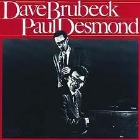 playing in the early days and lots of footage and photos of the large, affectionate and talented family of six children headed by Brubeck and his wife Iola. The program explains Mrs. Brubeck's crucial role in managing the original quartet's connection to college campuses, a move that established the band as a force in jazz and started a cultural trend. Desmond is amusing in his graphic description of Brubeck's tendency to wildness at the keyboard in the early years of their partnership.
playing in the early days and lots of footage and photos of the large, affectionate and talented family of six children headed by Brubeck and his wife Iola. The program explains Mrs. Brubeck's crucial role in managing the original quartet's connection to college campuses, a move that established the band as a force in jazz and started a cultural trend. Desmond is amusing in his graphic description of Brubeck's tendency to wildness at the keyboard in the early years of their partnership.
Apparently because of their closeness to Eastwood, the documentary brings in pop singer Jamie Cullum and crossover pianist David Benoit to discuss Brubeck's music, with occasional interjections by Bill Cosby. Eastwood's friend director George Lucas helps  make Eastwood's case that fellow northern Californians like Brubeck, Jack London and Ansel Adams are a breed apart. Sting and Yo-Yo Ma also make appearances, Ma in a lively cello duet with Brubeck's youngest son Matthew. The actor Alec Baldwin does the film's narration, which is spare, low-key and infrequent. The sound and pictures make the point: Dave Brubeck achieved success without varying from quiet, rigorous devotion to his principles. This documentary will charm his fans and advocates. It may make his detractors reconsider.
make Eastwood's case that fellow northern Californians like Brubeck, Jack London and Ansel Adams are a breed apart. Sting and Yo-Yo Ma also make appearances, Ma in a lively cello duet with Brubeck's youngest son Matthew. The actor Alec Baldwin does the film's narration, which is spare, low-key and infrequent. The sound and pictures make the point: Dave Brubeck achieved success without varying from quiet, rigorous devotion to his principles. This documentary will charm his fans and advocates. It may make his detractors reconsider.
TCM will precede the Brubeck documentary with a showing at 1:30 pm EST of the 1962 British movie All Night Long, a modern retelling of Shakespeare's Othello, in which Brubeck and Charles Mingus, his friend from early San Francisco days, make cameo appearances and play a duet.
Naturally, Brubeck's record companies are capitalizing on all of the fuss. Brubeck reissues abound. Concord, the music conglomerate that has acquired upwards of a dozen labels, owns Fantasy, a company Brubeck helped to found in 1949. Its two-CD compilation The Definitive Dave Brubeck reaches back far beyond the Fantasy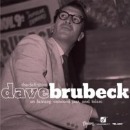 years to "I Found a New Baby," a solo he recorded in 1942 as a college student. It continues with the octet he formed after World War Two, trio performances from the late forties and early fifties and a substantial cross section of tracks by the quartet he formed with Paul Desmond in 1951. It includes the original quartet's breathtaking 1953 performances of "How High the Moon" at Oberlin College and "All the Things You Are" at College of the Pacific. The second disc concentrates on music from Brubeck's Concord and Telarc albums of the '70s, '80s and later.
years to "I Found a New Baby," a solo he recorded in 1942 as a college student. It continues with the octet he formed after World War Two, trio performances from the late forties and early fifties and a substantial cross section of tracks by the quartet he formed with Paul Desmond in 1951. It includes the original quartet's breathtaking 1953 performances of "How High the Moon" at Oberlin College and "All the Things You Are" at College of the Pacific. The second disc concentrates on music from Brubeck's Concord and Telarc albums of the '70s, '80s and later.
Brubeck joined Columbia Records in the mid-1950s. It became the label on which he had his biggest hits, beginning in the days when jazz still enjoyed widespread popularity. In his Columbia career the centerpiece, as far as popular success went, was "Take Five," 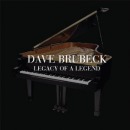 the first jazz single to sell more than a million copies, in defiance of the inroads rock and roll was making into popular taste. Columbia/Legacy's Dave Brubeck: Legacy Of A Legend is another two-CD compilation. It fills in the decades between Fantasy and Concord and incorporates tracks from 15 albums, and collaboration with Carmen McRae, Louis Armstrong, Jimmy Rushing and Leonard Bernstein. "Take Five," of course, is part of the package, and so is a previously unissued concert version of "Three to Get Ready," with the classic quartet full of good humor nearly to the point of giddiness. Brubeck's son Darius contributes liner notes of substance.
the first jazz single to sell more than a million copies, in defiance of the inroads rock and roll was making into popular taste. Columbia/Legacy's Dave Brubeck: Legacy Of A Legend is another two-CD compilation. It fills in the decades between Fantasy and Concord and incorporates tracks from 15 albums, and collaboration with Carmen McRae, Louis Armstrong, Jimmy Rushing and Leonard Bernstein. "Take Five," of course, is part of the package, and so is a previously unissued concert version of "Three to Get Ready," with the classic quartet full of good humor nearly to the point of giddiness. Brubeck's son Darius contributes liner notes of substance.
As if that weren't enough, Sony Masterworks has also reissued two packages containing 10 of Brubeck's most successful or important Columbia albums in their entirety. The first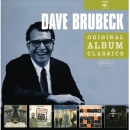 volume of Dave Brubeck: Original Album Classics has Brubeck Plays Brubeck, Brandenburg Gate Revisited, Gone with the Wind, Jazz Goes to College and Jazz Impressions of New York.
volume of Dave Brubeck: Original Album Classics has Brubeck Plays Brubeck, Brandenburg Gate Revisited, Gone with the Wind, Jazz Goes to College and Jazz Impressions of New York.
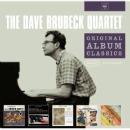 The second 5-volume set has the "time" series, Time Out, Countdown: Time in Outer Space, Time Further Out, Time Changes and Time In. And they're going at fire-sale prices. Columbia has never been shy about reissuing, re-reissuing and re-re-reissuing music, but this landslide of Brubeck albums, some long unavailable, is unprecedented. And welcome.
The second 5-volume set has the "time" series, Time Out, Countdown: Time in Outer Space, Time Further Out, Time Changes and Time In. And they're going at fire-sale prices. Columbia has never been shy about reissuing, re-reissuing and re-re-reissuing music, but this landslide of Brubeck albums, some long unavailable, is unprecedented. And welcome.
Randy Weston, The Storyteller (Motéma). This is the latest chapter in the 84-year-old pianist's long-running love story about Africa. Weston's African Rhythms Sextet includes the great 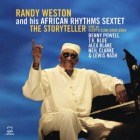 trombonist Benny Powell in one of his last recordings, alto saxophonist T.K. Blue, bassist Alex Blake, drummer Lewis Nash and conga specialist Neil Clarke. He made the album almost exactly a year ago in performance at Dizzy's Club Coca Cola in New York. With the rhythm section generating heat near combustion levels, some of the ensemble passages approximate the excitement of the Dizzy Gillespie big band of the late forties that blended Afro-Cuban rhythms into jazz. Solos by all hands express the passion—sometimes smoldering, sometimes volcanic— that has typified Weston's music for six decades. The entire CD is a highlight, but Weston devotees will find particular stimulation and a good deal of humor in the reworking of his classic "Hi Fly" and its recapitulation, "Fly Hi." Nash and Clarke achieve moments of jaw-dropping percussion virtuosity. Weston's piano playing continues to embody the spirits of Thelonious Monk and Duke Ellington.
trombonist Benny Powell in one of his last recordings, alto saxophonist T.K. Blue, bassist Alex Blake, drummer Lewis Nash and conga specialist Neil Clarke. He made the album almost exactly a year ago in performance at Dizzy's Club Coca Cola in New York. With the rhythm section generating heat near combustion levels, some of the ensemble passages approximate the excitement of the Dizzy Gillespie big band of the late forties that blended Afro-Cuban rhythms into jazz. Solos by all hands express the passion—sometimes smoldering, sometimes volcanic— that has typified Weston's music for six decades. The entire CD is a highlight, but Weston devotees will find particular stimulation and a good deal of humor in the reworking of his classic "Hi Fly" and its recapitulation, "Fly Hi." Nash and Clarke achieve moments of jaw-dropping percussion virtuosity. Weston's piano playing continues to embody the spirits of Thelonious Monk and Duke Ellington.
John McNeil/Bill McHenry, Chill Morn He Climb Jenny (Sunnyside). McNeil tempers his trumpet virtuosity with shots of wry. In tenor saxophonist McHenry he has found his ideal counterpart and foil. In this successor to their superb 2008 CD Rediscovery, the pianoless quartet reprises and, to put it mildly, reinterprets additional pieces from the repertoires of the Gerry Mulligan and Chet Baker quartets of the 1950s. There are hints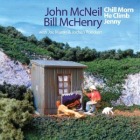 at the timbres and moods of those groups, but this is no ghost band. Free but tethered to tradition, it is in the spirit of 21st century downtown Manhattan and Brooklyn jazz. Most often, bassist Joe Martin and drummer Jochen Rueckert lay down measured swing that leaves McNeil and McHenry at their leisure to roam freely within—and occasionally outside of—the bounds of "Carioca," "Moonlight in Vermont," "Aren't You Glad You're You" and from the pen of Russ Freeman, "Batter Up," the tricky blues "Bea's Flat" and "Maid in Mexico." Throughout, the horns contrive little duet riffs that they manage to make sound as if they had just thought of them. Three of the tunes depart from the west coast play list. Thad Jones' "Three And One" and Wilbur Harden's loping "I Got Rhythm" contrafact "Wells Fargo" inspire some of the quartet's most passionate work of the date, which was before an audience at the Cornelia Street Café in Greenwich Village. Miles Davis' "Pfrancing," is primarily a blues background for McNeil's parting announcement. That enigmatic album title? It's an anagram of the leaders' names.
at the timbres and moods of those groups, but this is no ghost band. Free but tethered to tradition, it is in the spirit of 21st century downtown Manhattan and Brooklyn jazz. Most often, bassist Joe Martin and drummer Jochen Rueckert lay down measured swing that leaves McNeil and McHenry at their leisure to roam freely within—and occasionally outside of—the bounds of "Carioca," "Moonlight in Vermont," "Aren't You Glad You're You" and from the pen of Russ Freeman, "Batter Up," the tricky blues "Bea's Flat" and "Maid in Mexico." Throughout, the horns contrive little duet riffs that they manage to make sound as if they had just thought of them. Three of the tunes depart from the west coast play list. Thad Jones' "Three And One" and Wilbur Harden's loping "I Got Rhythm" contrafact "Wells Fargo" inspire some of the quartet's most passionate work of the date, which was before an audience at the Cornelia Street Café in Greenwich Village. Miles Davis' "Pfrancing," is primarily a blues background for McNeil's parting announcement. That enigmatic album title? It's an anagram of the leaders' names.
With Dave Brubeck's 90th birthday five days away, anticipation of the event is materializing in news stories, interviews, radio airplay, web tributes and accolades from colleagues and admirers. Marc Myers' piece in The Wall Street Journal includes this paragraph:
Clean living, a happy marriage and global popularity have made Mr. Brubeck a media darling--and a target of envy. "Even in the '50s I'd hear critics and musicians say, 'Oh, Brubeck, he's different'--meaning separate from the rest," Mr. Brubeck said. "Others described my music as West Coast cool or light. Listen to our version of 'Look for the Silver Lining' from 1952. Tell me, what's cool about that?"
You be the judge. The recording is from 1951, not '52, but 59 years later, it's understandable that anyone could lose track of a year. This was an NBC Radio live remote from the Surf Club in Hollywood. The record label lists ony Brubeck, Paul Desmond and bassist Wyatt Ruther. The drummer is Herb Barman.
Cool? Please use the comment link at the bottom of this post.
Woody Herman First Herd, December 10, 1945
Neil Hefti, arranger
Woody Herman, vocal
Sonny Berman, trumpet solo
Bill Harris, trombone solo
AJ Ads
AJ Blogs
AJBlogCentral | rssculture
Terry Teachout on the arts in New York City
Andrew Taylor on the business of arts & culture
rock culture approximately
Laura Collins-Hughes on arts, culture and coverage
Richard Kessler on arts education
Douglas McLennan's blog
Dalouge Smith advocates for the Arts
Art from the American Outback
Chloe Veltman on how culture will save the world
For immediate release: the arts are marketable
No genre is the new genre
David Jays on theatre and dance
Paul Levy measures the Angles
Judith H. Dobrzynski on Culture
John Rockwell on the arts
innovations and impediments in not-for-profit arts
Jan Herman - arts, media & culture with 'tude
dance
Apollinaire Scherr talks about dance
Tobi Tobias on dance et al...
jazz
Howard Mandel's freelance Urban Improvisation
Focus on New Orleans. Jazz and Other Sounds
Doug Ramsey on Jazz and other matters...
media
Jeff Weinstein's Cultural Mixology
Martha Bayles on Film...
classical music
Fresh ideas on building arts communities
Greg Sandow performs a book-in-progress
Harvey Sachs on music, and various digressions
Bruce Brubaker on all things Piano
Kyle Gann on music after the fact
Greg Sandow on the future of Classical Music
Norman Lebrecht on Shifting Sound Worlds
Joe Horowitz on music
publishing
Jerome Weeks on Books
Scott McLemee on books, ideas & trash-culture ephemera
theatre
Wendy Rosenfield: covering drama, onstage and off
visual
Public Art, Public Space
Regina Hackett takes her Art To Go
John Perreault's art diary
Lee Rosenbaum's Cultural Commentary


